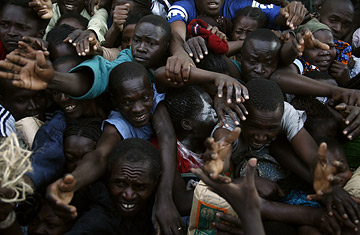
People push to receive food distributed by the Kenyan Red Cross in the Mathare slum in Nairobi.
(2 of 2)
For the world's poorest people, the price spikes are disastrous. AID officials say that millions who previously eked out enough to feed their families can no longer afford the food in their local stores, and are seeking help from relief organizations. "We are seeing a new face of hunger," says Josette Sheeran, executive director of the U.N.'s World Food Program (WFP). "People who were not in the urgent category are now moving into that category." Last month she bluntly told Western donors that WFP will trim its aid programs this year unless it can raise an extra $500 million to cover the rising cost of the food that it now provides to about 73 million people, including many who survive on just 50 cents a day. The U.S. Agency for International Development (AID) — the WFP's biggest donor — said last month it had been forced to cut about $120 million from future aid programs to pay for current commitments. "That money is gone," says Jonathan Dworken, deputy director of AID's Food for Peace program. He says its commodity expenses have soared by 41% in six months.
Yet despite the widespread demonstrations, the food crisis has been largely ignored until recently by U.S. and European officials — who pay for much of the world's food aid — partly, says von Braun, "because no one is starving in rich countries." Last October, shortly before food riots began exploding across West Africa, the WFP's director in Mauritania, Gian Carlo Cirri, flew to a donors' meeting in Senegal and warned Western aid officials that "2008 will be a very dangerous year," with rising food prices increasingly liable to hurt middle-class city dwellers, "who are prone to demonstrating." Similarly, von Braun says he has felt "like a Cassandra" in Washington in recent years, as he tried to warn U.S. officials numerous times that a global food crisis was looming. Even now, he says, "the specialists share our sense of urgency, but it hasn't broken out of that circle yet."
That could change if food riots begin to threaten the survival of governments. In many poor countries, the protests have been fueled by pent-up anger against authoritarian or corrupt officials, some of whom have earned fortunes from oil and minerals while locals are struggling to buy food. "It's a bad combination," says Alioune Tine, head of a human-rights organization in Senegal. Voters in Pakistan trounced President Pervez Musharraf's party in crucial parliamentary elections last month, in part because many could no longer afford staple foods — and blamed the government. "We are worried about terrorism and those other things, but first we are worried about basic needs," said a 24-year-old nurse in Islamabad, shopping in the capital's busy Aab Para market during election season last month. "People want a person who can fix this problem."
Any fix will take time. Several African countries have begun planting high-protein, pest-resistant rice crops, and aid organizations are beginning to hire locals for new job programs to help people pay their food bills. In the poorest parts of Asia and Africa, officials hope that sky-high food prices might lift out of poverty small farmers who have barely scraped by on low crop prices — a hope that would get a big boost if the rich world agreed to cut agricultural subsidies in the current round of trade talks. In parts of Bangladesh, farm workers' wages have doubled in a year, says Kader, the project coordinator in Dhaka. But they too need to buy food. And for most people, food prices are rising faster than earnings. With shelves in Pakistan, Burkina Faso, Senegal and elsewhere stocked with unaffordable food, people might still opt to burn government buildings and attack stores. That, at least, is free.
